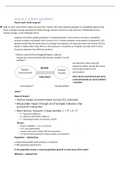College aantekeningen
College aantekeningen Environmental Economics (30L304-B-6)
- Instelling
- Tilburg University (UVT)
In this document you'll find all the lecture slides (1 up to and including 15) with very extensive notes (basically literally what the professors say during their explanation) which are obligatory for the exam. Goodluck with studying!
[Meer zien]




